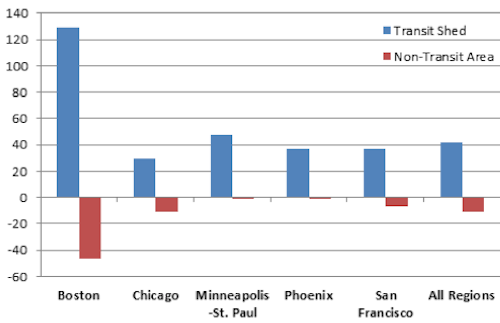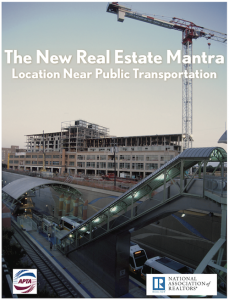Study: Connection Between Transit and Real Estate Value
A study released this month looked at five regions and found a connection between home values and transit:
From the Executive Summary:
Overall there was a substantial decline in average residential sales prices in the study regions between 2006 and 2011. However, in all of the regions, the decline in average residential sales prices within the transit shed was lower than in the region as a whole or the non-transit area. Across the study regions, the transit shed outperformed the region as a whole by 41.6 percent. Figure 1 shows the percent change in average residential sales prices in the transit shed and non- transit area relative to the regional percent change in price.
Within a given region, heavy rail, light rail, and BRT transit sheds held their value best. In addition to having higher frequency service and better transit connectivity, these types of fixed-guideway transit stations also tend to be located in areas that are more walkable, have higher residential density, and better access to jobs. Commuter rail sheds also saw a smaller decline in average residential sales prices than the region as a whole.


From the Conclusion:
Transit type also had an effect on the resilience of property values, which benefited more from transit that was well connected and had a higher frequency of service. Although most commuter rail transit sheds still saw a smaller decline in average residential sales prices than the region as a whole, heavy rail, BRT, and light rail transit sheds outperformed commuter rail transit sheds within and across regions. Heavy rail transit sheds had significantly higher levels of transit access, as measured by the Transit Connectivity Index and the Transit Access Shed, than the commuter rail sheds. Average monthly household transportation costs were also substantially lower in the heavy rail than the commuter rail sheds, indicating that the heavy rail sheds had not only higher levels of transit service, but were more location efficient overall. For most property types, the transit shed outperformed the region; however, unlike with transit type, there were no consistent trends across regions.
In addition to providing consumers and planners with information, the findings support investment in transit and encourage development in location efficient areas. The presence of fixed-guideway transit not only benefits individual property owners, it also supports a more resilient tax base.
I read about the study here. This is no surprise to many of us, but others won’t believe the results. “Everyone aspires to a McMansion in suburbia and driving everywhere” they’ll proclaim.
It’s 2013, not 1963!
– Steve Patterson
Good to see this quantified.
The other way to look at this is that denser, higher-priced areas are more suited to supporting good public transit systems – chicken or egg?
The other half of the equation is how the “transit shed” is defined compared to a more consistent measurement, like the SMSA. If the transit shed is relatively small (here, Tampa, Phoenix) compared to areas with more and more comprehensive options (Chicago, San Francisco, Denver), the dynamics should change, as well. If you work in a city with a thriving CBD, transit becomes a better commuting option. If you work someplace where employment centers are not very concentrated, “good” transit becomes a lot more problematic, and real estate values will reflect that . . . .
How will the next housing bust called the “senior sell-off”, predicted for 2020, impact the importance of transit shed? See link: http://www.theatlanticcities.com/housing/2013/03/aging-baby-boomers-and-next-housing-crisis/4863/
The young families that want a suburban house will buy the houses closer to suburban transit stations while the others decline in value.
I’m not quite sure if it’s that simple. A large part of the “senior sell-off” will involve a lifestyle shift from commuting (for work) to no longer commuting on a daily basis. Or, to put it another way, if transit is such a critical component, why is it so under-developed in most current retirement meccas (Florida, Arizona, the Carolinas)?
For most, the senior sell-off is relatively early in life, while you are still able-bodied and driving a car is not an issue. But many people think about seniors wanting transit because they are not able to drive.
People tend to think that if you are too old to drive, then you can just take the bus. But actually, if you are too old to drive, you are also usually too old to take transit. I know people in wheelchairs use transit, but for the elderly, many require extra help. They can’t walk to a bus stop, maybe using a walker, and board a bus.
That’s why senior apartments provide vans to take residents to Wal-mart, Schnucks, the bank, and so on. You don’t see the residents of those places walking out to the bus stop. I look at the senior apartments around this area, and I never see residents from those apartments waiting for the bus, even though the bus stop is directly in front or beside the apartments. For example, think of the apartments at Kingshighway and Manchester or those at S. Grand and Magnolia.
A lot of this is due to the fact that if you have spent your life driving, you still see the bus as something you just don’t do. But also because elderly people often need extra help. By the way, that’s one reason we have Call-a Ride.
Very true, but I see seniors at the Heritage Housing on Olive using the #10 MetroBus all the time. They’re urban seniors though, they may not have been as tied to driving as we are today.
We’ve been having senior sell offs of sorts. Every major city has had this happen when mom and pop raised the family and the kids want to get out to the suburbs and away from living on top of each other. And what of immigrants? Where are they going to live. They’ll be plenty of buyers as long as the financings are there (and the houses are still standing…some of this new construction is worse than the 3 little pigs digs). This isn’t saying that I’m for it. I wish the sprawl would stop, but I think at most, it will just slow.
The biggest impetus for moving to the suburbs is better schools – fewer and less-attractive commuting options is part of the price people are willing to pay . . . –
When I moved to DC in 2010, my most important requirement for housing was that it be within 2 blocks of a metro stop. People who sign leases and buy homes in this town without considering distance from a metro stop are often looked at like they have two heads.
be careful about these studies. In many cases, new rail lines go through the very areas which
are experiencing growth for other reasons. In st Louis, for example, all new construction in downtown,
the Barnes area and Clayton can be “attributed” to light rail. Transit construction should be based on
transit needs, not on the questionable effect it has on stimulating new construction. Just look at the
transit stations on Manchester, Rock Road and Page to see a lack of new construction I am a strong
advocate of light rail, but also one of intellectual honesty